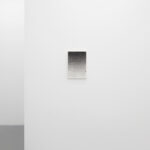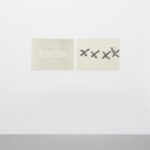... and then night!
02.12.2022 - 18.01.2023
AnaMary Bilbao
Michal Martychowiec
Xisco Mensua
Manuel M. Romero
Ian Waelder
Curated by Aurélien Le Genissel
‘Suddenly the lives of fireflies seem foreign, troubling,
as if made from the surviving matter
-luminescent but pale, weak, often greenish
of ghosts .’
Georges Didi-Huberman. Survival of the Fireflies
In a certain way, the works presented in this exhibition can be seen as incidental fireflies glowing in the night. Sparkling and gleaming, their appearance opposes the twilight kingdom that T.S. Eliot spoke of to describe the "whimper" of our times. Nonetheless, we are not dealing with an opaque kind of night. Rather with that "kingdom −of raw, cruel, fierce light− of the merchandise", criticised by Guy Debord, with those "fierce projectors" of Pasolini, that are blinding us. We are surrounded by an abundance of clarity, glances and images, by CCTV cameras and reality TV spotlights, by stories and overly lit stadiums, by illuminated politicians and ostensive bodies.
In order not to be engulfed by this blinding gloom, we have to fight against the seduction, the speed, and the productivity of the hypertrophic images that flood visual capitalism. To propose what Georges Didi- Huberman (1) calls 'firefly-images', intermittent flickers, unstable proposals, splinters of the world, casual shards, those 'surviving images' − as he describes them in another famous book − which we can find, for instance, in the old photograms recovered and processed by AnaMary Bilbao in her series of prints. An archaeology of the image where randomness and resilience offer a new hermeneutics of looking, a more transparent and crude approach to the exercise of observation.
The random words, disconnected signs and accidental lines on a black background of AnaMary Bilbao’s work seem to correspond to the abstract paintings by Manuel M. Romero, where blobs of paint, uneven surfaces and materials oscillate between a calculated gesture and the rests of a seemingly unattainable experience. There is something of what Huberman calles ‘glimpses’, a more profound and gentle way of letting ourselves be traversed by perception. 'That thing that appears leaves, before it disappears, something like the trail of a question, memory or desire', explains the philosopher in a sentence that could well be my perfect definition of an artwork. One of Romero's paintings could also serve as a unique example of those fireflies: against a black background, white points sprout up, looking precisely as if they were pushing the darkness away in the middle of the night, witnessing something that we will never understand, but that we can perhaps manage to glimpse or imagine.
And all these works presented here, in a way, reflect upon their own essence, upon their very status as images, not trying to hide their fragility, imperfection and contingency. They do not try to seem more than they are, as we can see in Ian Waelder's photographs, where arbitrariness, chance and failure are present in the repeated, quasi-absurd attempt to photograph a simple beer bottle. What is more, he does it while accepting and embracing the irregular pixelization of an overly enlarged image. The everyday character of the banal, "traces of tiny but decisive events, which is to say open onto fields of infinite possibilities", as Huberman would say again. The same happens with the sculpture I remember better days, where shoes and an iron bar seem to transport us to a lost time and to expired circumstances.
Xisco Mensua’s film scenes look somehow tiny as well. Rooted in the mundane intimacy of the lock down, all the possibilities here are open thanks to the references to his sources of inspiration: the texts he quotes, the distilled ideas, or the excerpt of innumerable movies. His cinema of personal transcendence reminds us of the early years of video art and contains echoes of the "little stories within the great History" that Pasolini talked about. The trivial daily life becomes universal when inserted in a pandemic background, with a precise editing style that reminds on both Godard's intellectualism and the existential density of Jonas Mekas.
"Searching for the ghost of an image", as Hito Steyerl used to say about these "poor images" that somehow resonate in the home-made frames of Mensua's movie. These ghosts − according to the quote at the beginning of this text − are made of the pale and weak luminescence of surviving matter. We find ourselves tame and passive in front of the disembodied power of the grandiose and productive images, just like the panda bear − symbol of the modern man − in Michał Martychowiec’s work Panda contemplating the black square. But here, again, not everything is what it seems, and the formalism of the black square might conceal the boldness of the living.
In his famous poem À une Passante, in 1855, Charles Baudelaire wrote: "A lightning flash... then night! Fleeting beauty." This exhibition aims to recover that lightning strike, that tremor in the dark, that moan of light that makes the night shudder. Sparks of sense that "appear, but on their way to disappearing", far from overwhelming truths, totalitarian horizons; as remnants of possibilities that help flourish the thought of an ephemeral image.
They are inviting us to look better, to approach "trembling with tenderness" the wonder of the occasional.










